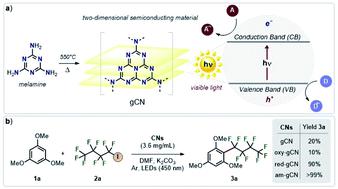当前位置:
X-MOL 学术
›
Chem. Sci.
›
论文详情
Our official English website, www.x-mol.net, welcomes your
feedback! (Note: you will need to create a separate account there.)
Radical defects modulate the photocatalytic response in 2D-graphitic carbon nitride
Chemical Science ( IF 7.6 ) Pub Date : 2022-08-12 , DOI: 10.1039/d2sc03964h Edoardo Raciti 1, 2 , Sai Manoj Gali 1 , Michele Melchionna 2 , Giacomo Filippini 2 , Arianna Actis 3 , Mario Chiesa 3 , Manuela Bevilacqua 4, 5 , Paolo Fornasiero 2, 5 , Maurizio Prato 2, 6, 7 , David Beljonne 1 , Roberto Lazzaroni 1
Chemical Science ( IF 7.6 ) Pub Date : 2022-08-12 , DOI: 10.1039/d2sc03964h Edoardo Raciti 1, 2 , Sai Manoj Gali 1 , Michele Melchionna 2 , Giacomo Filippini 2 , Arianna Actis 3 , Mario Chiesa 3 , Manuela Bevilacqua 4, 5 , Paolo Fornasiero 2, 5 , Maurizio Prato 2, 6, 7 , David Beljonne 1 , Roberto Lazzaroni 1
Affiliation

|
Graphitic carbon nitride (gCN) is an important heterogeneous metal-free catalytic material. Thermally induced post-synthetic modifications, such as amorphization and/or reduction, were recently used to enhance the photocatalytic response of these materials for certain classes of organic transformations, with structural defects possibly playing an important role. The knowledge of how these surface modifications modulate the photocatalytic response of gCN is therefore not only interesting from a fundamental point of view, but also necessary for the development and/or tuning of metal-free gCN systems with superior photo-catalytic properties. Herein, employing density functional theory calculations and combining both the periodic and molecular approaches, in conjunction with experimental EPR measurements, we demonstrate that different structural defects on the gCN surface generate distinctive radical defect states localized within the electronic bandgap, with only those correlated with amorphous and reduced gCN structures being photo-active. To this end, we (i) model defective gCN surfaces containing radical defect states; (ii) assess the interactions of these defects with the radical precursors involved in the photo-driven alkylation of electron-rich aromatic compounds (namely perfluoroalkyl iodides); and (iii) describe the photo-chemical processes triggering the initial step of that reaction at the gCN surface. We provide a coherent structure/photo-catalytic property relationship on defective gCN surfaces, elaborating how only specific defect types act as binding sites for the perfluoroalkyl iodide reagent and can favor a photo-induced charge transfer from the gCN surface to the molecule, thus triggering the perfluoroalkylation reaction.
中文翻译:

自由基缺陷调节二维石墨氮化碳的光催化响应
石墨氮化碳(gCN)是一种重要的非均相无金属催化材料。最近,热诱导的合成后修饰(例如非晶化和/或还原)被用于增强这些材料对某些类别的有机转化的光催化响应,其中结构缺陷可能起重要作用。因此,这些表面改性如何调节 gCN 的光催化响应的知识不仅从基本的角度来看是有趣的,而且对于开发和/或调整具有优异光催化性能的无金属 gCN 系统也是必要的。在这里,采用密度泛函理论计算并结合周期性和分子方法,结合实验 EPR 测量,我们证明了 gCN 表面上的不同结构缺陷会产生位于电子带隙内的独特的自由基缺陷态,只有那些与非晶态和还原的 gCN 结构相关的缺陷态才是光活性的。为此,我们 (i) 对包含自由基缺陷状态的缺陷 gCN 表面进行建模;(ii) 评估这些缺陷与参与富电子芳族化合物(即全氟烷基碘)的光驱动烷基化的自由基前体的相互作用;(iii) 描述在 gCN 表面触发该反应的初始步骤的光化学过程。我们在有缺陷的 gCN 表面上提供了连贯的结构/光催化性能关系,
更新日期:2022-08-12
中文翻译:

自由基缺陷调节二维石墨氮化碳的光催化响应
石墨氮化碳(gCN)是一种重要的非均相无金属催化材料。最近,热诱导的合成后修饰(例如非晶化和/或还原)被用于增强这些材料对某些类别的有机转化的光催化响应,其中结构缺陷可能起重要作用。因此,这些表面改性如何调节 gCN 的光催化响应的知识不仅从基本的角度来看是有趣的,而且对于开发和/或调整具有优异光催化性能的无金属 gCN 系统也是必要的。在这里,采用密度泛函理论计算并结合周期性和分子方法,结合实验 EPR 测量,我们证明了 gCN 表面上的不同结构缺陷会产生位于电子带隙内的独特的自由基缺陷态,只有那些与非晶态和还原的 gCN 结构相关的缺陷态才是光活性的。为此,我们 (i) 对包含自由基缺陷状态的缺陷 gCN 表面进行建模;(ii) 评估这些缺陷与参与富电子芳族化合物(即全氟烷基碘)的光驱动烷基化的自由基前体的相互作用;(iii) 描述在 gCN 表面触发该反应的初始步骤的光化学过程。我们在有缺陷的 gCN 表面上提供了连贯的结构/光催化性能关系,










































 京公网安备 11010802027423号
京公网安备 11010802027423号